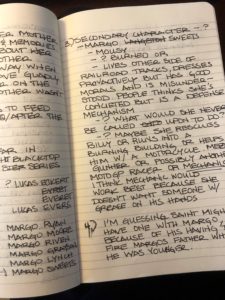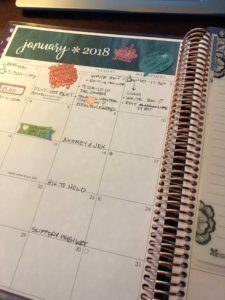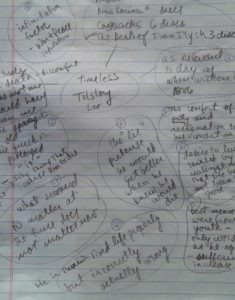Self-doubt is like a disease that goes undetected, sneaks in, and metastasizes when I’m not looking. It sits like a lump in my mind. It’s awful because it can lead to depression. Creative people deal with this every day. And inevitably, when it latches on to my psyche, it leads to fear and then procrastination. Because I can’t fail at something if I don’t start it, right? But then I think of my mantra, “Failure is a bridge to success.” So, I can only keep looking forward.
The start of 2018 is a good one, even if it has been a rocky road. There have been some bumps, okay a lot of bumps, which is self-doubt. I’m still confident that my plan is manageable, which means even the days that I’m down, my goal is still in my mind. It pushes me forward with my writing and art. And I’m still using the bullet journal to see my accomplishments.
 The days I wrote and didn’t paint or draw, I used a couple of Donald Maass books on writing. The Emotional Craft of Fiction: How to Write with Emotional Power, Develop Achingly Real Characters, Move Your Readers, and Create Riveting Moral Stake, and his Writing 21st Century Fiction: High Impact Techniques for Exceptional Storytelling. February was a fun, productive month in character development. The exercises will lead to a better outline and scenes that are full and beautiful with story. Each book has great lessons at the end of each section. Questions are listed so I can express the people I create in a more meaningful way. Most questions ask, how would a character react or function to inner and outer conflicts? They help define characters in a way that is more in-depth and intense. The reader will latch onto them to encourage experiencing the emotions the hero and heroines elicit. That’s what I want. It’s what my writing is missing. I even created another character that I didn’t see coming to add more tension to the story arc, which could lead to another book in the series.
The days I wrote and didn’t paint or draw, I used a couple of Donald Maass books on writing. The Emotional Craft of Fiction: How to Write with Emotional Power, Develop Achingly Real Characters, Move Your Readers, and Create Riveting Moral Stake, and his Writing 21st Century Fiction: High Impact Techniques for Exceptional Storytelling. February was a fun, productive month in character development. The exercises will lead to a better outline and scenes that are full and beautiful with story. Each book has great lessons at the end of each section. Questions are listed so I can express the people I create in a more meaningful way. Most questions ask, how would a character react or function to inner and outer conflicts? They help define characters in a way that is more in-depth and intense. The reader will latch onto them to encourage experiencing the emotions the hero and heroines elicit. That’s what I want. It’s what my writing is missing. I even created another character that I didn’t see coming to add more tension to the story arc, which could lead to another book in the series.
There have also been places where my scenes are flat. They have no meaning to the story, or they aren’t becoming a part of who the character is, or fails to show what the place means to a character. I recently finished a chapter and shared it with my writer’s group, Deadwood Writers, for specifically this goal. I wanted the chapter to feel as if the reader was stepping into the soul of the character. That the place I was creating was a living memory of what the character experienced throughout her life and to have the main heroine understand that it was something she could/would want, or as someone put it in the writer’s group, or not. In conclusion, I decided my character isn’t ready yet to deal with what she’s feeling. So, I had to create a space that was lived in and had a good history. But at this point she must have it on pause, like a still painting in the back of her mind, ready to bring it back to life when she’s ready. I was pleased with the result. But you’ll have to wait to read it since it’s in the sequel to Hot Blacktop.
 I’ve also worked on some fun projects in my art life, which I also listed in my bullet journal. I was on a mission to see where my art could fit into retail locations, and online at an Etsy store that I’ve started to create. I asked myself questions regarding starting a business along with talking with small gift shop store owners where I frequent. How can I sell my art? Where is the best place to do that? How do you choose the art you sell? Do I need a lawyer to create a business? How do I price my art? I did research online looking up other artists. I found videos, and articles, and will continue to develop what I intend to do.
I’ve also worked on some fun projects in my art life, which I also listed in my bullet journal. I was on a mission to see where my art could fit into retail locations, and online at an Etsy store that I’ve started to create. I asked myself questions regarding starting a business along with talking with small gift shop store owners where I frequent. How can I sell my art? Where is the best place to do that? How do you choose the art you sell? Do I need a lawyer to create a business? How do I price my art? I did research online looking up other artists. I found videos, and articles, and will continue to develop what I intend to do.
Even though I stumbled in February, not working as many days as I did in January, I still made good progress. I can’t let the days of idleness get to me. I’m still doing what I love. I’m still learning. That’s all that matters.

 At the library, I find several nondescript volumes lacking flashy colors, fonts and modern graphics. Recognizable titles include War and Peace (1400 pages), Anna Karenina (750 pages), The Cossacks (160 pages) and The Death of Ivan Ilyich (53 pages). I weigh my decision because quite literally my book bag is an unhealthy amount of heavy, and the winner is The Death of Ivan Ilyich. I load the three audio disks for my next commute to work and prepare for an easy week of listening to some old guy’s story about a different time and place. Instead, I discover “a dimension as vast as space and timeless as infinity . . . [that] lies between the pit of man’s fears and the summit of his knowledge.” It is an area called the Tolstoy Zone.1
At the library, I find several nondescript volumes lacking flashy colors, fonts and modern graphics. Recognizable titles include War and Peace (1400 pages), Anna Karenina (750 pages), The Cossacks (160 pages) and The Death of Ivan Ilyich (53 pages). I weigh my decision because quite literally my book bag is an unhealthy amount of heavy, and the winner is The Death of Ivan Ilyich. I load the three audio disks for my next commute to work and prepare for an easy week of listening to some old guy’s story about a different time and place. Instead, I discover “a dimension as vast as space and timeless as infinity . . . [that] lies between the pit of man’s fears and the summit of his knowledge.” It is an area called the Tolstoy Zone.1